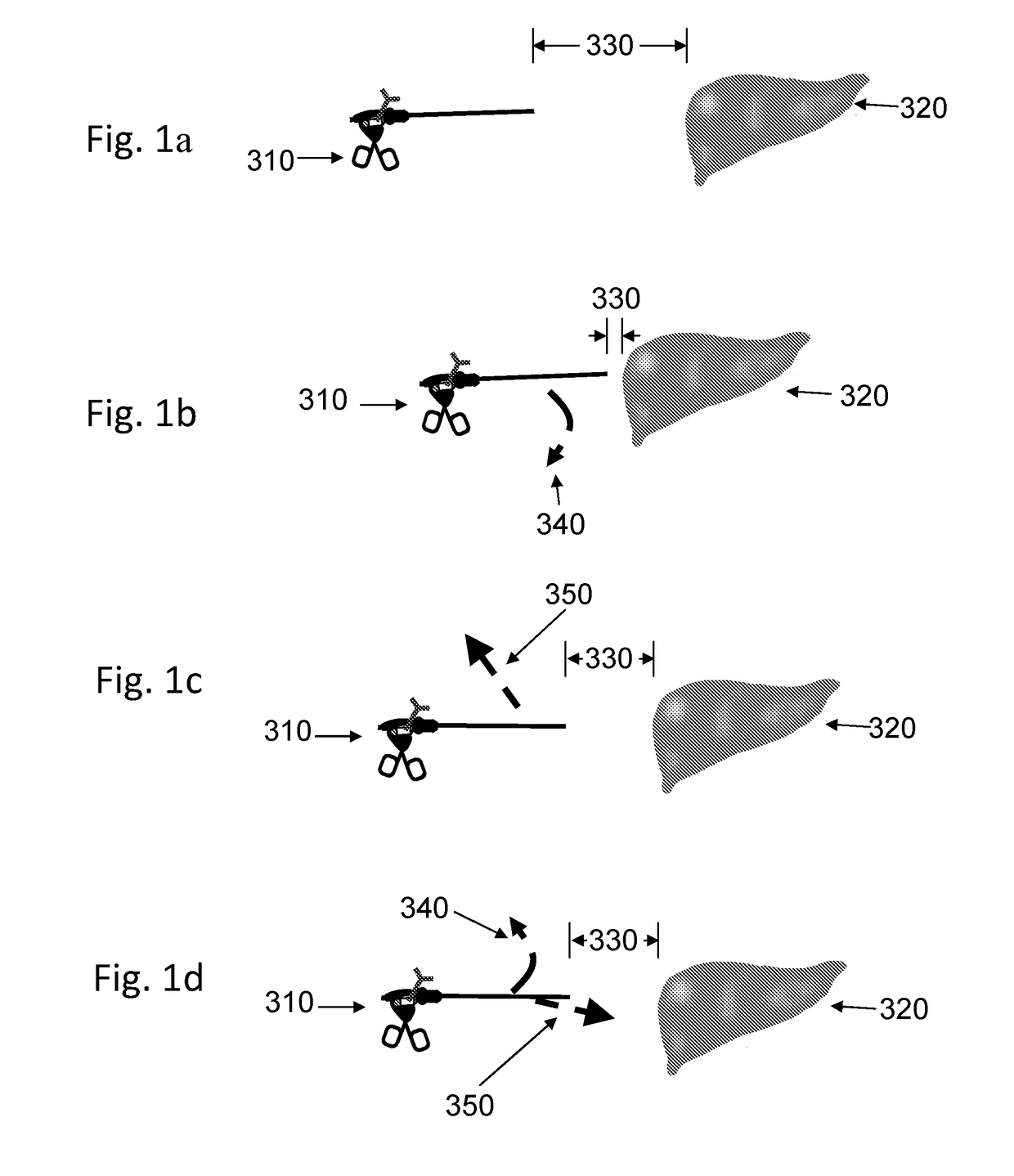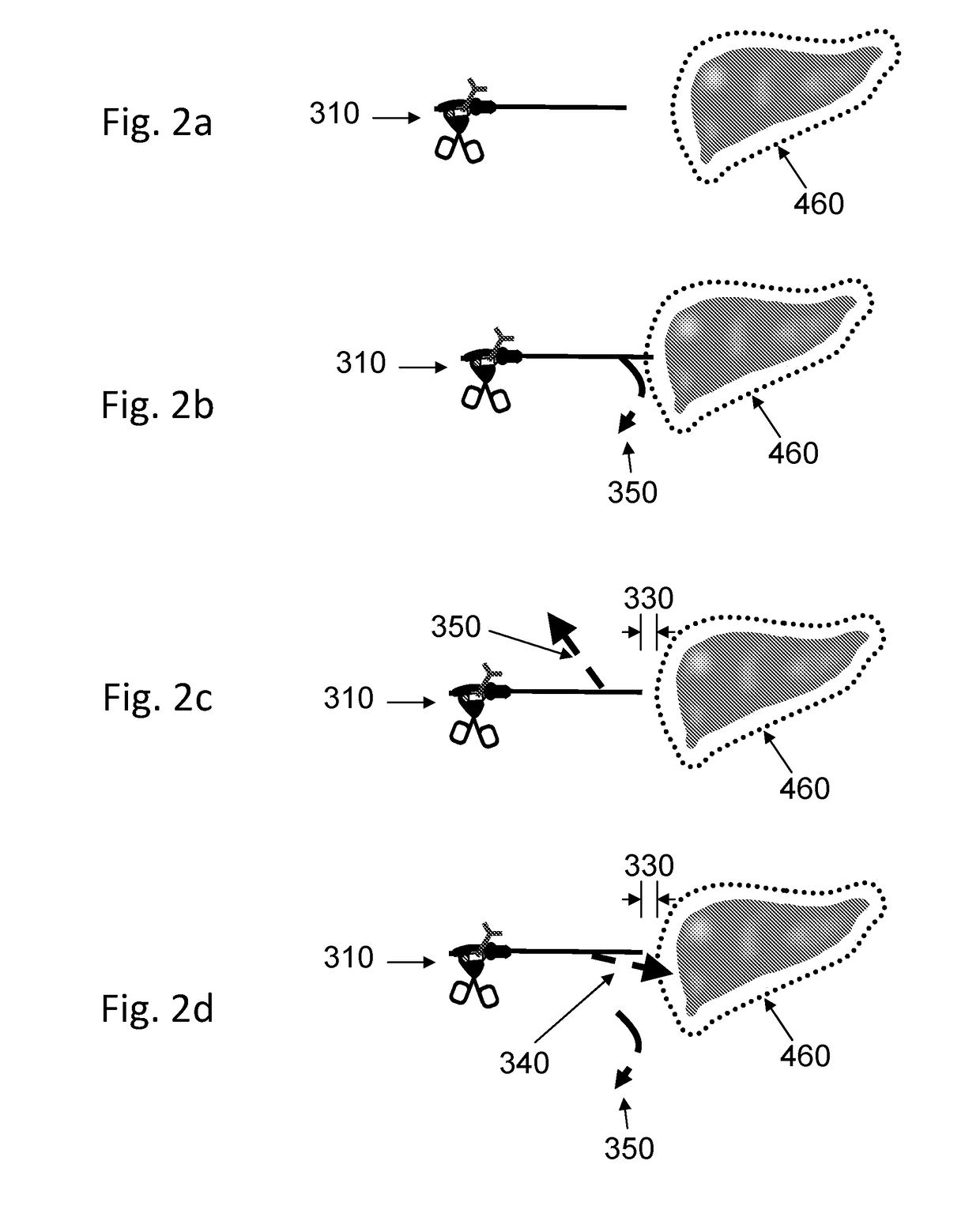Improved interface for laparoscopic surgeries - movement gestures
a technology of laparoscopic surgery and interface, applied in the field can solve the problems of not being able to address another complicating interface aspect of laparoscopic surgery, not being able to disclose the control of the endoscope, and expensive equipment, etc., and achieve the effect of improving the interface for laparoscopic surgery
- Summary
- Abstract
- Description
- Claims
- Application Information
AI Technical Summary
Benefits of technology
Problems solved by technology
Method used
Image
Examples
example 1
System with Collision Avoidance System
[0252]One embodiment of such a rule-based system will comprise the following set of commands:
[0253]Detection (denoted by Gd):
[0254]Gd1 Tool location detection function
[0255]Gd2 Organ (e.g. Liver) detection function
[0256]Gd3 Movement (vector) calculation and estimation function
[0257]Gd4 Collision probability detection function
[0258]Tool Instructions (denoted Gt):
[0259]Gt1 Move according to manual command
[0260]Gt2 Stop movement
[0261]The scenario—manual move command by the operator:
[0262]Locations Gd1(t) and Gd2(t) are calculated in real time at each time step (from an image or location marker).
[0263]Tool movement vector Gd3(t) is calculated from Gd1(t) as the difference between the current location and at least one previous location (probably also taking into account previous movement vectors).
[0264]The probability of collision—Gd1(t)—is calculated, for example, from the difference between location Gd1 and location Gd2 (the smaller the distance, t...
example 2
System with Soft Control—Fast Movement when Nothing is Nearby, Slow Movement when Something is Close
[0269]One embodiment of such rule-based system comprises the following set of commands:
[0270]Detection (denoted by Gd):
[0271]Main Tool location detection function (denoted by GdM);
[0272]Gd-tool1-K—Tool location detection function;
[0273]Gd-organ2-L—Organ (e.g. Liver) detection function;
[0274]Gd3 Main Tool Movement (vector) calculation and estimation function;
[0275]Gd4 Proximity probability detection function;
[0276]Tool Instructions (denoted Gt):
[0277]Gt1 Movement vector (direction and speed) according to manual command
[0278]The scenario—manual move command by the operator:
[0279]Locations GdM(t), Gd-tool1-K(t) and Gd-organ2-L(t) are calculated in real time at each time step (from image or location marker).
[0280]Main Tool Movement Vector Gd3(t) is calculated per GdM (t) as the difference between the current location and at least one previous location (probably also taking into account pr...
example 3
System with No-Fly Rule / Function
[0283]In reference to FIG. 2, which shows, in a non-limiting manner, an embodiment of a tracking system with no-fly rule. The system tracks a tool 310 with respect to a no-fly zone (460), in order to determine whether the tool will enter the no-fly zone (460) within the next time step. In this example, the no-fly zone 460 surrounds the liver.
[0284]FIGS. 2a and 2b show how the behavior of the system depends on the location of the tool tip with respect to the no-fly zone, while FIGS. 2c and 2d show how movement of the tool affects the behavior.
[0285]In FIG. 2a, the tool 310 is outside the no-fly zone rule / function 460 and no movement of the tool is commanded. In FIG. 2b, the tool 310 is inside the no-fly zone 460.
[0286]The no-fly zone rule / function performs as follows:
[0287]In the embodiment illustrated, a movement 350 is commanded to move the tool 310 away from the no-fly zone 460. In other embodiments, the system prevents movement further into the no-...
PUM
 Login to View More
Login to View More Abstract
Description
Claims
Application Information
 Login to View More
Login to View More - R&D
- Intellectual Property
- Life Sciences
- Materials
- Tech Scout
- Unparalleled Data Quality
- Higher Quality Content
- 60% Fewer Hallucinations
Browse by: Latest US Patents, China's latest patents, Technical Efficacy Thesaurus, Application Domain, Technology Topic, Popular Technical Reports.
© 2025 PatSnap. All rights reserved.Legal|Privacy policy|Modern Slavery Act Transparency Statement|Sitemap|About US| Contact US: help@patsnap.com



